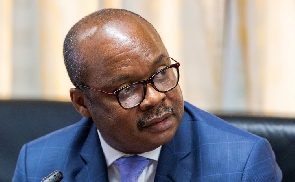 Dr Ernest Addition, Governor Bank of Ghana
Dr Ernest Addition, Governor Bank of Ghana
The Bank of Ghana (BoG) its debt to government which has been written off leading to huge losses included all the legacy debts of the Government of Ghana dating back to 1992.
It included the accrued overdraft of 2022, overdraft to Cocobod, the Covid-19 Bond, and even BoG holdings of Telecom Malaysia (Ghana Telecom Bonds) Bonds and Tema Oil Refinery (TOR) bonds issued by Government.
A statement issued by Dr Ernest Addison, Governor of BoG explained that as of 2015, the accumulated claims on Government and Ghana Cocoa Board (COCOBOD) were about GHC13 billion.
He emphasized that the debt is not about recent debt alone saying almost all lending from the International monetary Fund (IMF), including the Extended Credit Facility and the Rapid Credit Facility during the COVID-19 pandemic, and all financial sector resolution bonds have all been added as BoG lending to government.
He pointed out that the losses reported were technical losses arising from the haircut and the application of accounting standards in particular, IFRS 9 to estimate expected credit losses over the tenor of government debt held by BoG.
He therefore stated that the loss is not money lost by BoG through its operations in 2022.
Rather, he said it should be looked at as a reflection of the total cost of the economic and social crisis the country faced over the years and an attempt to resolve a major structural problem of the economy.
Dr Addison pointed out that this is not the first time that the Bank has gone into negative equity recalling that during the early years of structural adjustment, very large exchange rate depreciations led to revaluation losses that drove the Bank into negative Equity.
“Indeed, anytime the economy faces major challenges, the Bank of Ghana balance sheet suffers, and the equity position moves into negative territories,” he said.
The Central Bank Governor stated that in 2017 and 2018, BoG incurred similar negative equity from the impairment of legacy liquidity support loans granted in 2015 and 2016 to insolvent banks, which external auditors impaired due to the doubtful prospects of recovering from those insolvent banks.
However, BoG recovered and generated profits of GH₵1.6 billion in 2019, GH₵1.5 billion in 2020 and GH₵ 1.4 billion in 2021.
Dr Addison is optimistic that BoG’s current financial condition will not impact negatively on the operations of the Bank.
According to him, the International Monetary Fund (IMF) Technical Assistance mission validated this conclusion, before the necessary decisions were taken.
He said the opinion of the IMF team BoG was policy solvent and would remain so, as it had enough income to cover monetary policy operational costs.
The Central bank Governor assured that BoG had sufficient capital amounting to about 15% of its total liabilities.
He announced that the IMF recommendation that the Bank retains all profits and a reassessment should be made in the year 2027.
He promised that the Bank will also manage to reduce its operational costs during this period.
Central Banks can operate effectively even with negative equity, as the central banks of Chile, the Czech Republic, Israel and Mexico have done over several years.
If losses persist, however, problems can emerge, as has been the case in some emerging and developing economies with weak governmental institutions.
In particular, sizable net liabilities denominated in foreign currency can disable a financially weak central bank.
Central bank losses are not an indication of a policy error and need not hamper the effectiveness of monetary and financial policies.
A central bank’s credibility depends on its ability to achieve its mandates.
Losses do not jeopardise that ability and are sometimes the price to pay for achieving those aims.
Stakeholders and the public should appreciate that central banks’ policy mandates come before profits.